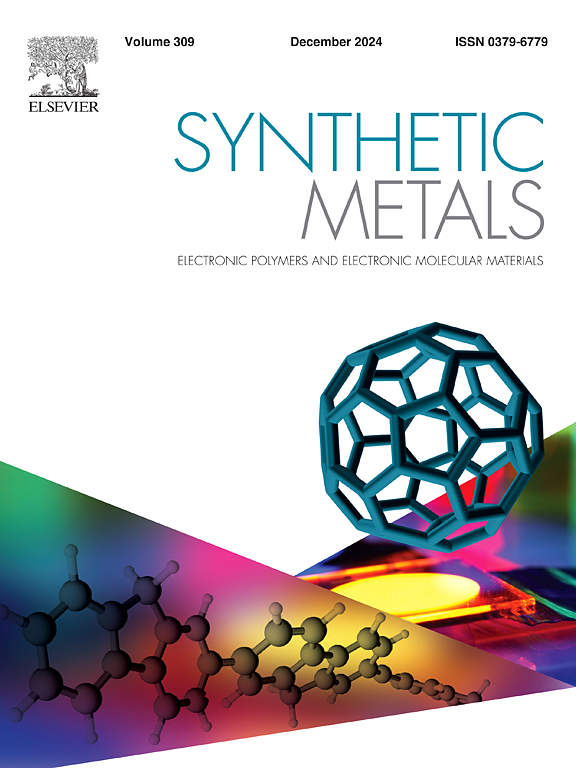通过改变噻吩给体单元具有可调谐光电性能的二氟化苯并噻唑基给体-受体电致变色聚合物
IF 4.6
3区 材料科学
Q2 MATERIALS SCIENCE, MULTIDISCIPLINARY
引用次数: 0
摘要
本研究通过电化学沉积法制备了两种二氟化D-A聚合物P(FF-Th)和P(FF-EDOT)。以噻吩和EDOT为给体,通过Stille偶联法合成了两种由二氟化D-π-A-π-D单体衍生的聚合物。随后,采用几种分析技术评价了两种二氟化D-A聚合物的光电和电致变色性能。此外,为了揭示影响其性能的内在机制,深入探讨了噻吩给体单元结构对合成聚合物电致变色性能的影响。与FF-Th相反,FF-EDOT具有较低的初始氧化电位,从而易于合成聚合电位降低的优质二氟化聚合物。此外,即使在1000次循环后,二氟化P(FF-EDOT)薄膜仍保持77.4%的氧化还原活性。引入EDOT单元后,FF-EDOT的荧光光谱和紫外光谱出现红移。电化学和光谱电化学方法的研究表明,这两种聚合物都具有空穴掺杂和电子掺杂的特性。值得注意的是,P(FF-EDOT)具有更小的光学带隙、更低的氧化电位和更好的动态稳定性。这两种新开发的二氟化D-A聚合物的光学带隙是可以调节的,它们的电致变色性能受到其噻吩基给电子单元的不同给电子能力的显著影响。本文章由计算机程序翻译,如有差异,请以英文原文为准。
Difluorinated benzothiadiazole based donor-acceptor electrochromic polymers with tunable optoelectronic properties by varying the thiophene donor units
In this study, two difluorinated D-A polymers, P(FF-Th) and P(FF-EDOT), were prepared through electrochemical deposition method. The two polymers originated from difluorinated D-π-A-π-D monomers were synthesized via Stille coupling, using thiophene and EDOT as donors. Subsequently, several analytical techniques were employed to evaluate the optoelectronic and electrochromic properties of the two difluorinated D-A polymers. Furthermore, to reveal the intrinsic mechanisms influencing their performance, the impact of the thiophene donor units' structure on the electrochromic properties of the synthesized polymers was thoroughly explored. Contrary to FF-Th, FF-EDOT features a lower initial oxidation potential, thereby easing the synthesis of superior-quality difluorinated polymers with a diminished polymerization potential. In addition, the difluorinated P(FF-EDOT) films retain an impressive 77.4 % of their redox activity even after 1000 cycles. The fluorescence spectra and UV of FF-EDOT show a redshift after introducing the EDOT unit. Studies using electrochemical and spectroelectrochemical methods indicate that both polymers have hole-doping and electron-doping characteristics. Notably, P(FF-EDOT) has a smaller optical band gap, lower oxidation potential, and better dynamic stability. The optical band gap of these two newly developed difluorinated D-A polymers can be adjusted, with their electrochromic properties being significantly influenced by the differing electron-donating capacities of their thiophene-based donor units.
求助全文
通过发布文献求助,成功后即可免费获取论文全文。
去求助
来源期刊

Synthetic Metals
工程技术-材料科学:综合
CiteScore
8.30
自引率
4.50%
发文量
189
审稿时长
33 days
期刊介绍:
This journal is an international medium for the rapid publication of original research papers, short communications and subject reviews dealing with research on and applications of electronic polymers and electronic molecular materials including novel carbon architectures. These functional materials have the properties of metals, semiconductors or magnets and are distinguishable from elemental and alloy/binary metals, semiconductors and magnets.
 求助内容:
求助内容: 应助结果提醒方式:
应助结果提醒方式:


